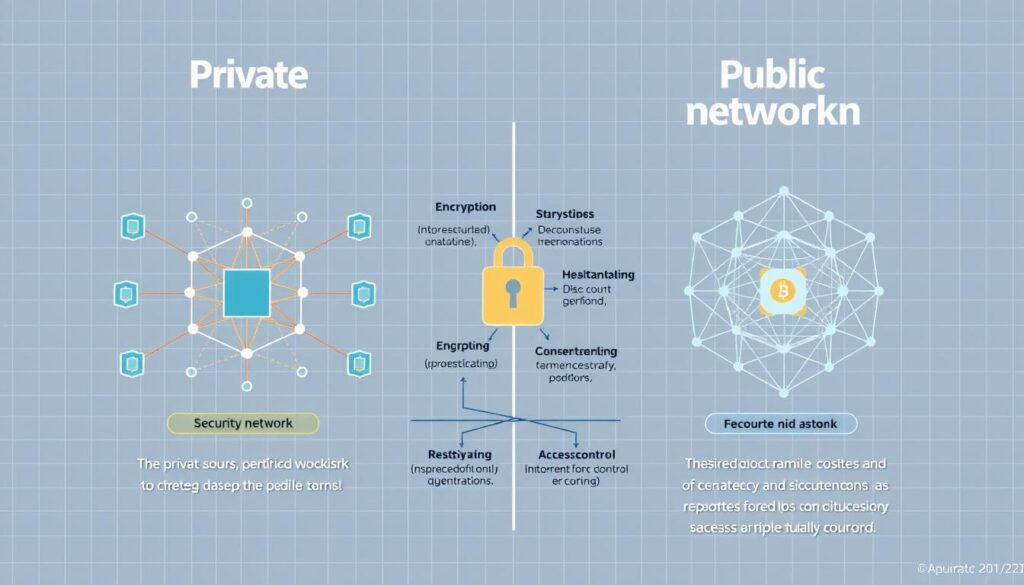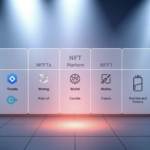Now Reading: Private vs Public Blockchain Networks: Understanding the Differences
- 01
Private vs Public Blockchain Networks: Understanding the Differences
Private vs Public Blockchain Networks: Understanding the Differences

Distributed ledger systems are reshaping industries, but not all operate the same way. Two distinct models dominate the conversation: permissioned systems requiring authorization and open-access platforms allowing global participation. These frameworks differ in governance, accessibility, and use-case suitability, creating unique value propositions for businesses.
Financial institutions often favor controlled environments for sensitive transactions, while supply chain operators leverage transparent networks for cross-border tracking. This blockchain security comparison reveals why enterprises choose specific architectures—some prioritize data privacy, others value community-driven validation.
The debate between decentralized vs centralized blockchain models intensifies as adoption grows. Retail giants now use immutable ledgers for product authentication, while healthcare organizations explore secure patient record sharing. These real-world applications demonstrate how network design directly impacts scalability and trust mechanisms.
Key Takeaways
- Permissioned systems offer restricted access, while open networks enable public participation
- Financial sectors prioritize controlled environments for compliance-sensitive operations
- Supply chain solutions benefit from transparent, tamper-proof transaction histories
- Decentralized validation reduces single-point failure risks in public networks
- Enterprise adoption drives innovation in hybrid blockchain configurations
Recent advancements in consensus algorithms address historical limitations, making both models more viable for mainstream use. From smart contracts in insurance to digital identity verification, organizations must evaluate their needs against each network’s strengths. This analysis provides the foundation for choosing optimal solutions in our increasingly data-driven economy.
Blockchain Network Fundamentals
Blockchain technology operates as a system of interconnected rules and participants that collectively maintain digital trust. At its core, it combines cryptographic security with decentralized decision-making to create networks where data remains tamper-resistant and transparent. These systems vary in design but share foundational elements that enable secure peer-to-peer transactions without centralized oversight.
Core Principles of Distributed Ledger Technology
Distributed ledger technology (DLT) relies on three key concepts:
- Decentralized control: No single entity owns or controls the entire network
- Cryptographic hashing: Data blocks are linked through irreversible digital fingerprints
- Consensus validation: Network participants must agree on transaction legitimacy
These principles enable blockchain networks to maintain accuracy while resisting manipulation. Public networks like Bitcoin apply them in open environments, while private systems such as Hyperledger adapt them for controlled business settings.
Essential Blockchain Components
Two critical elements define how blockchain networks operate and enforce security protocols.
Nodes and Network Participants
Nodes form the backbone of blockchain infrastructure. In permissionless networks like Ethereum, anyone can operate a node to validate transactions. Bitcoin miners compete to solve complex puzzles, earning rewards for adding blocks. Conversely, permissioned blockchains restrict node operation to authorized entities. Hyperledger Fabric uses validator nodes pre-approved by network administrators to maintain enterprise-grade efficiency.
Consensus Mechanisms Overview
Consensus protocols determine how networks achieve agreement. The table below contrasts popular approaches:
| Mechanism | Energy Use | Speed | Use Case |
|---|---|---|---|
| Proof of Work (PoW) | High | Slow | Public networks (Bitcoin) |
| Practical Byzantine Fault Tolerance (PBFT) | Low | Fast | Private networks (Hyperledger) |
Blockchain governance models directly influence consensus choices. PoW prioritizes security through computational work, while PBFT emphasizes speed by trusting verified participants. This distinction highlights the permissioned vs permissionless blockchain divide: open networks favor decentralization, while closed systems optimize for controlled performance.
Public Blockchain Networks Explained
Public blockchains redefine how digital systems operate by eliminating centralized control. These open networks allow global participation while maintaining security through advanced cryptography. Let’s explore their unique architecture and real-world implementations.
Decentralized Architecture Characteristics
Public blockchains thrive on principles that prioritize accessibility and collective oversight. Their design ensures no single entity dictates network rules or controls data flow.
Permissionless Access and Participation
Anyone with internet connectivity can join public networks as users, developers, or validators. This openness enables:
- Borderless transaction capabilities
- Transparent audit trails for all activities
- Community-driven protocol upgrades
This accessibility fuels innovation but creates challenges in scaling. Networks must balance inclusivity with efficient operation.
Cryptoeconomic Incentives Structure
Public blockchains use token rewards to align participant interests. Bitcoin’s proof-of-work system pays miners through:
- 6.25 BTC block rewards (post-2024 halving)
- Transaction fee bonuses
These incentives secure the network by making attacks economically impractical. Ethereum enhanced this model with its EIP-1559 upgrade, which burns base fees to stabilize blockchain transaction costs.
Notable Public Blockchain Examples
Two networks demonstrate public blockchain evolution while addressing different needs. Their technical choices directly impact user experiences and DeFi applications.
Bitcoin: Pioneer Cryptocurrency Network
The original blockchain prioritizes security over speed, with key features:
| Feature | Impact |
|---|---|
| 1MB block size | 7 transactions/second limit |
| 10-minute blocks | High settlement assurance |
| Halving events | Controlled supply inflation |
Miners currently earn $350,000+ daily from fees alone, ensuring network security despite rising blockchain transaction costs during peak demand.
Ethereum: Smart Contract Platform
This programmable blockchain enables complex DeFi applications through:
- Turing-complete virtual machine
- Gas fee market dynamics
- Proof-of-stake validation
The 2022 Merge reduced energy use by 99.95%, while EIP-1559 burned $9.8 billion in ETH within two years. These changes aim to balance network fees with sustainable growth for financial applications.
Private Blockchain Networks Defined
While public blockchains dominate cryptocurrency discussions, private networks power critical enterprise operations. These permissioned systems combine blockchain’s security with corporate control, enabling businesses to streamline processes without exposing sensitive data. Let’s explore how controlled access and tailored implementations make private blockchains essential for modern organizations.
Controlled Access Infrastructure
Private blockchains operate like VIP clubs for data management. Access requires explicit approval from network administrators, creating a trusted ecosystem for business transactions.
Permissioned Node Participation
Enterprise blockchain solutions use certificate authorities to validate participants. Walmart’s food tracking system demonstrates this approach, where suppliers must obtain digital certificates before joining the Hyperledger Fabric network. This setup:
- Verifies participant identities through cryptographic keys
- Limits data access to authorized users
- Enables custom privacy settings for different user groups
Centralized Governance Models
Consortium-led decision-making sets private networks apart from public chains. In J.P. Morgan’s Onyx network for interbank settlements, member banks collectively:
- Approve protocol changes
- Validate transaction batches
- Manage system upgrades
Enterprise Blockchain Implementations
Major corporations are adopting private networks to solve specific operational challenges. These implementations balance transparency with business confidentiality.
Hyperledger Fabric Use Cases
Walmart’s food safety initiative showcases Hyperledger’s capabilities. The retail giant reduced traceability time from 7 days to 2.2 seconds by:
- Digitizing supply chain documentation
- Creating immutable quality control records
- Enabling real-time contamination tracking
R3 Corda Financial Applications
R3 Corda specializes in financial enterprise blockchain solutions. J.P. Morgan’s Onyx network processes $1 billion daily in interbank settlements using:
| Feature | Benefit | Impact |
|---|---|---|
| Atomic Settlements | Instant transaction finality | Reduces counterparty risk |
| Smart Contract Templates | Standardized agreements | Cuts negotiation time by 65% |
| Data Vaults | Regulatory-compliant storage | Simplifies audit processes |
These implementations prove private networks can deliver public blockchain’s benefits while meeting corporate security needs. By combining controlled access with specialized features, enterprise blockchain solutions address real-world business challenges effectively.
Private vs Public Blockchain Networks: Key Differences

Public and private blockchains operate like digital twins with opposing personalities. While both use distributed ledger technology, their approaches to access, governance, and transparency create distinct ecosystems. These differences directly impact how organizations implement blockchain solutions.
Access Control and Participation
Public networks resemble open-air markets – anyone can join without permission. Bitcoin’s pseudonymous system lets users transact with just a wallet address. Private chains function like gated communities. Hyperledger Fabric requires pre-approved identities, making it popular for KYC/AML implementations in banking.
This access divide creates performance gaps. Bitcoin handles 7 transactions per second (TPS), while Hyperledger achieves 3,000+ TPS. Enterprises needing speed often choose private networks to avoid blockchain scalability issues plaguing public chains.
Network Governance Structures
Public blockchains use decentralized governance models. Ethereum upgrades require community consensus through Ethereum Improvement Proposals. Private networks employ centralized control – a consortium of banks might jointly manage a trade finance blockchain.
Morgan Stanley’s blockchain settlement system shows this contrast. Their private network allows instant adjustments to compliance rules, impossible on public chains like Ethereum.
Transaction Validation Processes
Validation methods highlight operational contrasts:
- Public networks: Energy-intensive proof-of-work (Bitcoin)
- Private networks: Efficient Practical Byzantine Fault Tolerance (Hyperledger)
These technical choices directly affect transaction costs and finality times. Public chain validations can take minutes, while private networks confirm transactions in seconds.
Data Visibility and Transparency
Ethereum’s public ledger reveals every transaction detail to network participants. Private chains offer selective transparency – Morgan Stanley’s trade settlements show only approved data to authorized parties.
This visibility spectrum impacts regulatory compliance. Private networks simplify KYC/AML implementations through controlled data sharing, while public chains face challenges verifying anonymous users.
The choice between networks ultimately depends on an organization’s need for openness versus control. As blockchain scalability issues drive innovation, hybrid models are emerging to bridge these differences.
Decentralization Spectrum Analysis
Blockchain networks exist on a sliding scale of decentralization, with public and private systems occupying opposite ends. This spectrum directly impacts security, efficiency, and governance structures. Let’s examine how network architecture shapes operational dynamics and organizational control.
Public Network Decentralization Features
Global Node Distribution
Public blockchains like Ethereum demonstrate true decentralization with over 15,000 nodes spanning 75+ countries. This geographic diversity creates:
- Enhanced network resilience against localized outages
- Resistance to censorship or single-point control
- Democratic transaction validation processes
Consensus Algorithm Impacts
Proof-of-Work (PoW) systems consume significant energy – Bitcoin’s annual usage rivals Norway’s electricity consumption. However, emerging blockchain governance models are exploring hybrid approaches:
| Consensus Type | Energy Use | Validation Time | Node Participation |
|---|---|---|---|
| Proof-of-Work | High (650 TWh/yr) | 10+ minutes | Open |
| Proof-of-Stake | Low (0.01 TWh/yr) | 5-15 seconds | Token-based |
Private Network Centralization Tradeoffs
Pre-Approved Validator Selection
Enterprise systems like IBM Food Trust operate with just 28 authorized nodes. This controlled environment enables:
- Faster transaction processing (1,000+ TPS)
- Reduced energy consumption (85% less than public chains)
- Customizable governance rules
Enterprise Control Requirements
Private networks prioritize regulatory compliance over decentralization. Key features include:
- Role-based access permissions
- Centralized software updates
- Integrated audit trails
Emerging AI integration potential in private networks enables predictive analytics for supply chain management and automated compliance checks. This hybrid approach combines centralized efficiency with smart automation.
Security Considerations Compared
Blockchain network security isn’t one-size-fits-all – public and private systems employ fundamentally different protection strategies. While both use advanced cryptography, their approaches to risk management reflect contrasting priorities in accessibility versus control.

Public Network Security Model
Public blockchains face unique challenges due to their open participation model. Ethereum Classic’s 51% attacks in 2019 and 2020 demonstrated how malicious actors could temporarily control mining power to reverse transactions. These incidents highlight why large public networks require massive decentralization to maintain security.
51% Attack Vulnerabilities
Proof-of-Work systems remain susceptible to majority control attacks, though risks decrease as networks grow. The $1.1 million double-spend attack on Ethereum Classic showed how smaller public chains face greater exposure than giants like Bitcoin.
Cryptographic Protection Mechanisms
Public networks rely heavily on SHA-256 hashing and elliptic curve cryptography. Bitcoin’s blockchain has never been hacked thanks to its robust cryptographic design, though wallet security remains a separate concern.
Private Network Security Approach
Enterprise solutions like HSBC’s Voltron trade platform take a different tack. By limiting participation to vetted entities, these networks reduce external threats but face different challenges.
Permissioned Access Advantages
HSBC’s blockchain consortium uses identity verification and role-based permissions to control network access. This closed environment prevents anonymous bad actors while enabling faster transaction validation.
Internal Threat Management
Private networks combat insider risks through TLS certificates and granular activity monitoring. The Bankchain alliance in India uses real-time audit trails to detect suspicious patterns among authorized participants.
While public chains trust cryptography, private networks combine encryption with strict governance. Both models continue evolving – Ethereum’s shift to Proof-of-Stake addresses energy concerns while new zero-knowledge proofs enhance private chain privacy.
Performance and Scalability Comparison
Blockchain networks face critical challenges in balancing speed with security, creating distinct performance profiles for public and private systems. Scalability limitations often dictate real-world applications, making throughput and latency key factors for enterprises evaluating blockchain solutions.
Transaction Throughput Capabilities
Public blockchains like Bitcoin process 3-7 transactions per second (TPS), constrained by their 10-minute block confirmation times. Ethereum’s upgrade to proof-of-stake increased capacity to 20-30 TPS, but layer 2 solutions remain essential for scaling.
Public Network Limitations
Decentralized validation creates inherent bottlenecks. Bitcoin’s proof-of-work consensus requires global node synchronization, while Ethereum’s gas fees spike during network congestion. These blockchain scalability issues drive projects like Lightning Network, which processes micropayments off-chain.
Private Network Optimizations
Hyperledger Fabric achieves 3,500-20,000 TPS through streamlined consensus rules. R3 Corda’s notary clusters enable sub-second transaction finality for financial settlements. Enterprises optimize performance by:
- Restricting validator nodes to trusted partners
- Using practical Byzantine fault tolerance (PBFT) consensus
- Implementing parallel transaction processing
Network Latency Factors
Transaction confirmation times vary dramatically between network types. Public chains prioritize security over speed, while private systems optimize for rapid finality.
Consensus Mechanism Speeds
Proof-of-work systems average 10-60 minute confirmation windows versus private network PBFT consensus completing in 2-5 seconds. Hybrid approaches like Hedera Hashgraph’s gossip protocol achieve 3-5 second finality through virtual voting.
Node Geography Impacts
Global node distribution in public networks introduces 200-800ms latency between regions. Private operators minimize delays by:
- Locating nodes in centralized data centers
- Using content delivery networks
- Implementing geographic load balancing
| Performance Metric | Public Blockchain | Private Blockchain |
|---|---|---|
| Average TPS | 3-30 | 1,000-20,000 |
| Transaction Finality | 10+ minutes | <5 seconds |
| Latency Variance | High (global nodes) | Low (controlled nodes) |
| Layer 2 Solutions | Payment channels | Notary clusters |
These performance characteristics demonstrate why financial institutions favor private networks for high-volume transactions, while public chains dominate trustless value transfers. Layer 2 solutions continue bridging the gap, with Optimistic Rollups and ZK-SNARKs enhancing public network throughput without compromising decentralization.
Cost Structures and Economics
Blockchain networks operate under fundamentally different financial models depending on their architecture. Understanding these economic frameworks helps organizations budget effectively and avoid hidden expenses.

Public Network Transaction Costs
Public blockchains use market-driven pricing that fluctuates with network demand. Ethereum’s gas fees reached $200 per transaction during peak NFT activity in 2021, while AWS Managed Blockchain offers predictable pricing starting at $0.46/hour per member.
Gas fees and market dynamics
Three factors shape public network costs:
- Real-time computation requirements
- Cryptocurrency price volatility
- Network congestion patterns
This variable pricing contrasts with private networks’ fixed subscription models, creating budgeting challenges for frequent users.
Mining/staking expenses
Bitcoin miners spend over $30,000 per node on specialized hardware, while private networks using cloud solutions like Azure Blockchain Service deploy nodes for under $5,000 each. Energy consumption accounts for 90% of public network operational costs versus 35% in private setups.
Private Network Implementation Costs
Enterprise blockchain deployments require careful infrastructure planning. Initial investments typically break down as follows:
| Cost Category | Public Blockchain | Private Blockchain |
|---|---|---|
| Node Setup | $30,000 (mining rig) | $5,000 (cloud instance) |
| Transaction Fees | $1.50-$200 | $0.10-$2.00 |
| Annual Maintenance | Variable | $15,000 fixed |
Infrastructure investment
Private networks using Hyperledger Fabric typically require:
- $50,000-$200,000 initial deployment
- Multi-cloud redundancy systems
- Compliance auditing tools
Maintenance and upgrade expenses
Ongoing costs for private networks average 25% of initial investment annually, compared to public networks’ unpredictable fee structures. Version upgrades cost 40% less in permissioned environments due to centralized governance.
Regulatory Compliance Aspects
Compliance remains a critical hurdle for blockchain adoption, with public and private networks taking divergent approaches to regulatory requirements. Governments and financial institutions increasingly demand transparency, creating unique challenges for decentralized systems while offering opportunities for permissioned networks. This section examines how blockchain regulatory compliance shapes operational frameworks across both models.
Public Network Regulatory Challenges
Public blockchains face mounting scrutiny from global regulators due to their open nature. Recent studies show 78% of compliance officers view pseudonymous transactions as their top concern in crypto markets.
Pseudonymity Concerns
While wallet addresses don’t directly reveal identities, advanced analytics tools like Chainalysis demonstrate how transaction patterns can deanonymize users. This creates friction with strict KYC/AML regulations requiring verified participant identities.
Cross-Border Transaction Issues
The FATF Travel Rule mandates sharing sender/receiver data for transfers over $3,000 – a requirement public networks struggle to implement natively. Unlike SWIFT GPI’s controlled environment, decentralized networks lack centralized entities to enforce compliance.
Private Network Compliance Advantages
Permissioned blockchains excel in regulated environments through built-in governance features. Financial institutions processing $12B+ daily transactions now prefer private networks for their audit-friendly architecture.
Audit Trail Capabilities
Enterprise blockchains automatically generate immutable records meeting SEC 17a-4 requirements. SWIFT’s GPI Link platform demonstrates how private networks provide real-time audit trails while maintaining transaction privacy through advanced cryptographic methods.
KYC/AML Implementations
Private networks enable granular access controls and automated compliance checks. Major banks now integrate on-chain identity verification that exceeds traditional banking standards while maintaining operational efficiency.
| Compliance Feature | Public Blockchain | Private Blockchain |
|---|---|---|
| Identity Management | Pseudonymous | Verified Participants |
| Audit Readiness | Limited native tools | Built-in audit trails |
| Regulatory Reporting | Third-party solutions required | Automated compliance APIs |
| Cross-Border Compliance | Travel Rule challenges | GPI-style standardization |
As regulations evolve, blockchain solutions must balance innovation with compliance. Private networks currently lead in meeting strict financial regulations, while public chains are developing hybrid approaches through privacy-preserving compliance tools.
Enterprise Adoption Patterns
Businesses increasingly adopt blockchain networks tailored to their operational needs, with public and private implementations serving distinct purposes. Public chains excel in open ecosystems requiring transparency, while private networks prioritize controlled environments for sensitive operations. Let’s examine real-world applications shaping corporate blockchain strategies.
Public Blockchain Business Use Cases
Decentralized finance platforms dominate public blockchain utilization. Aave, a leading DeFi protocol, manages over $20 billion in total value locked, enabling peer-to-peer lending without traditional intermediaries. This contrasts sharply with conventional banking systems, offering 24/7 global access to financial services.
NFT Marketplaces
Platforms like OpenSea demonstrate public blockchain’s creative potential, hosting millions of digital collectibles and artwork. Key features driving adoption include:
- Immutable ownership records
- Royalty automation for creators
- Cross-platform interoperability
Private Blockchain Industry Solutions
Enterprise-focused networks address specific business requirements through permissioned access. Maersk’s TradeLens platform revolutionizes supply chain management by:
- Reducing documentation errors by 45%
- Cutting cargo transit times by 29%
- Connecting 150+ shipping organizations
Interbank Settlements
Financial institutions leverage private networks for high-value transactions. JPMorgan’s blockchain system processes $10 billion daily in cross-border payments, offering:
- Real-time transaction verification
- Enhanced regulatory compliance
- Reduced counterparty risks
| Metric | Public Blockchain (Aave) | Private Blockchain (JPMorgan) |
|---|---|---|
| Daily Value | $1.2B loans | $10B settlements |
| Participants | Open access | Verified institutions |
| Transaction Speed | 15-30 seconds |
Hybrid Blockchain Solutions
Businesses no longer face an either-or decision between public and private networks. Hybrid blockchain technology creates adaptive systems that combine permissioned controls with decentralized transparency. These solutions address complex needs like multi-party collaboration and secure data sharing across industries.
Combining Network Architectures
Hybrid models use modular designs that integrate different blockchain types. Consortium blockchains demonstrate this approach effectively:
Consortium blockchain models
Groups like banking alliances use semi-private ledgers where pre-approved validators maintain consensus. This balances decentralization with regulatory compliance. Participants share governance rights while excluding public miners.
Cross-chain interoperability
Protocols like Polkadot enable communication between separate networks. A supply chain system might connect a private inventory ledger to public payment channels. Atomic swaps and wrapped tokens facilitate asset transfers across chains.
Enterprise Hybrid Implementations
Major corporations deploy hybrid systems to solve specific operational challenges:
Dragonchain case study
Disney’s ticket platform uses Dragonchain’s public/private sharding. Sensitive customer data stays on permissioned nodes, while ticket availability updates publicly. This architecture prevents fraud while maintaining event transparency.
IBM Food Trust hybrid approach
Walmart’s food tracking system merges Hyperledger Fabric with IoT sensors. Suppliers update shipment details on a private chain, while temperature logs from public IoT devices trigger smart contracts. This dual-layer system reduces spoilage claims by 38%.
These implementations show how hybrid blockchain technology delivers customizable security and scalable data sharing. As cross-chain interoperability standards mature, expect more industries to adopt blended network designs.
Future Development Trends
Blockchain technology continues to evolve at breakneck speed, with public and private networks charting distinct innovation paths. As organizations demand specialized solutions, both architectures are pushing boundaries in scalability, privacy, and smart automation.
Public Network Evolution
Public blockchains face mounting pressure to improve transaction speeds while maintaining decentralization. Two key developments are reshaping their capabilities:
Layer 2 Scaling Solutions
Platforms like Polygon are revolutionizing Ethereum’s infrastructure through zkEVM rollups. These layer 2 solutions enable:
- 15,000+ transactions per second (vs Ethereum’s 15 TPS)
- 90% reduction in gas fees
- Full EVM compatibility for developers
Zero-Knowledge Proof Adoption
Projects like Chainlink’s hybrid smart contracts combine on-chain execution with off-chain computation. This approach enables:
- Private voting systems for DAOs
- Secure cross-chain asset transfers
- Regulatory-compliant DeFi products
Private Network Innovations
Enterprise blockchain solutions are focusing on enhanced confidentiality and intelligent automation:
Enhanced Privacy Features
Microsoft’s Azure Confidential Ledger demonstrates next-gen privacy through:
- Hardware-based trusted execution environments
- Cryptographic proof of data integrity
- Automated compliance reporting tools
AI Integration Potential
The FedNow instant payment system could leverage AI-enhanced blockchains for:
- Real-time fraud detection algorithms
- Predictive liquidity management
- Smart contract-based payment routing
| Innovation Area | Public Networks | Private Networks | Key Players |
|---|---|---|---|
| Scaling Tech | zk-Rollups | Consortium Chains | Polygon, Arbitrum |
| Privacy Solutions | ZK-SNARKs | Confidential Computing | Zcash, Microsoft |
| AI Integration | Oracle Networks | Predictive Analytics | Chainlink, FedNow |
These advancements create new possibilities for hybrid systems. Financial institutions might combine public network liquidity with private network compliance controls, while supply chains could merge transparent tracking with confidential business data.
Making the Right Blockchain Choice
Selecting between private and public blockchain networks requires aligning technical capabilities with business objectives. Organizations must evaluate transaction volume needs, regulatory obligations, and resource allocation. Public chains like Bitcoin or Ethereum suit high-transparency blockchain use cases where decentralization matters most, while private networks address controlled enterprise blockchain solutions demanding speed and compliance.
A decision matrix comparing three factors clarifies options. High-frequency transactions favor private networks such as Hyperledger Fabric, used by FedEx for supply chain tracking at 2,000+ transactions per second. Strict compliance requirements tilt decisions toward permissioned systems, as seen in Walmart’s food traceability network. Budget-conscious projects often start with public chains, though Tesla’s 2021 Bitcoin experiment revealed scalability challenges during peak demand.
Enterprise blockchain solutions thrive when balancing customization with interoperability. FedEx’s Hyperledger implementation reduced customs clearance delays by 40% through private network efficiency, while public chains support borderless applications like DeFi platforms. Emerging hybrid models combine both architectures, letting companies like Siemens Energy manage public asset trading alongside private supply chain operations.
Assess data sensitivity and partner ecosystems before committing. Public networks work for trustless environments requiring immutable records, whereas private systems excel in collaborative enterprise settings. As blockchain use cases evolve, flexibility remains critical – 73% of enterprises now adopt multi-chain strategies according to Deloitte’s 2023 report. Start with pilot projects mirroring real-world needs, then scale based on performance metrics and stakeholder feedback.















